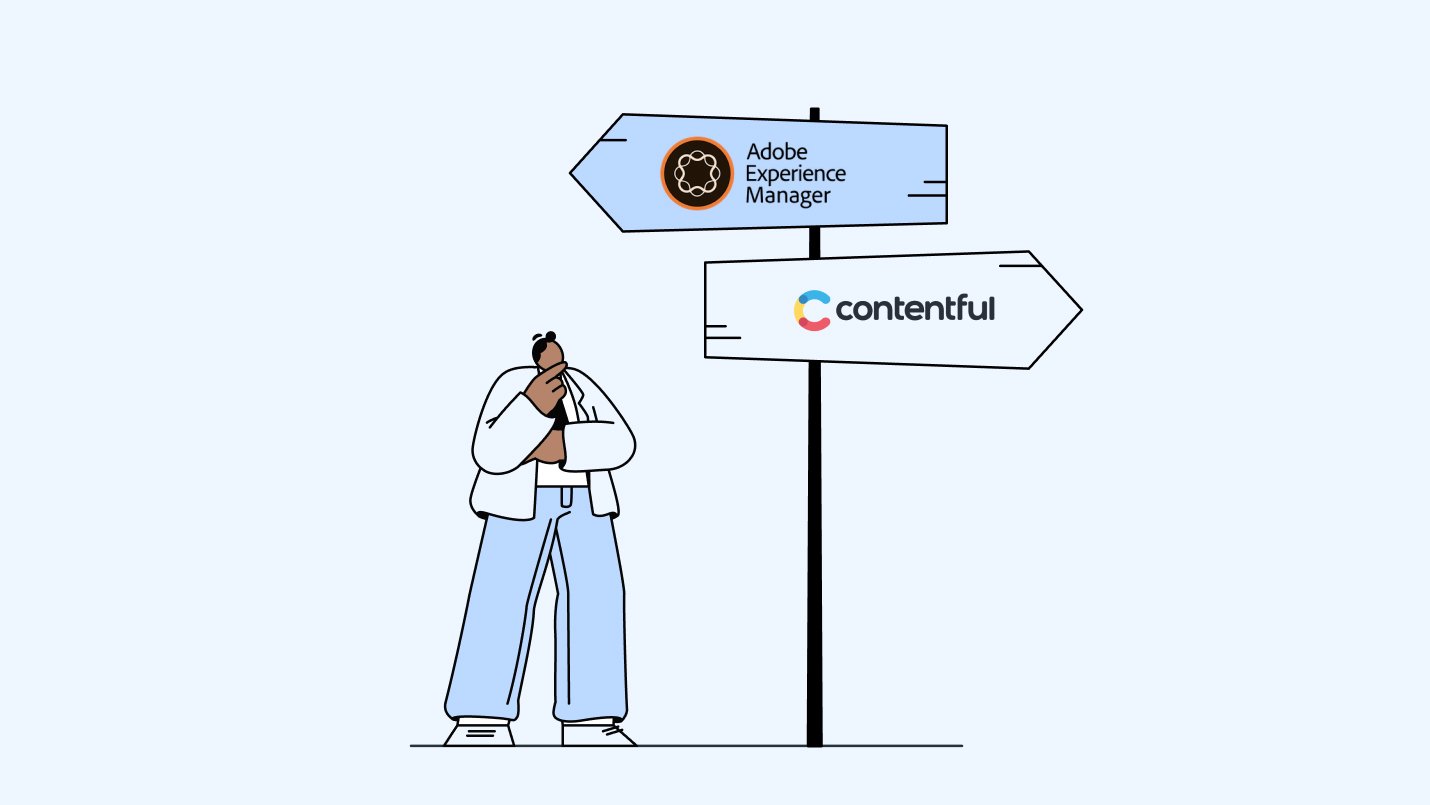The main difference between Adobe Experience Manager (AEM) and Contentful is in cost and complexity, with AEM’s CMS targeting large enterprise users with complex needs while Contentful offers a solution that targets small to large organizations with more user-friendly solutions.
In this guide, you will find a full comparison between these two composable CMS platforms to help you choose which platform is right to help craft your content. This guide will look at:
- The key features of AEM vs Contentful
- Benefits and drawbacks of each CMS
- Pricing considerations
- Positive and negative feedback from real users
Disclaimer: The information below is accurate as of 11th November 2024.
AEM (Adobe Experience Manager) Sites Overview
Adobe Experience Manager (AEM) is actually a bundle of products. AEM’s content management system (CMS) is known as “Adobe Experience Manager Sites,” helps businesses to create, manage, and deliver digital experiences across channels. AEM also has a digital asset management (DAM) product, known as “Adobe Experience Manager Assets,” which provides automation and tools to source, adapt and deliver assets across channels.
Adobe previously offered AEM as a licensed product for on-premise, but today primarily focuses on providing AEM as a Cloud Service.
Key features of Adobe Experience Manager Sites
Adobe Experience Manager Sites is designed to help you manage multiple digital properties, with:
- Flexible editing tools: AEM features a WYSIWYG editor, editable templates and components, and integrations with Word and Google Docs to make it easy to create or edit pages.
- Adobe GenAI for Experience Manager Sites: Adobe’s AI tool is integrated into the CMS to autonomously support both content generation and image generation, helping deliver personalization at scale.
- Visual media conversion: AEM can convert files to different sizes or formats at scale to fit different channels.
- Personalization and optimization: Easily create content variations on each channel to create hyper-specific experiences for all of your target personas, with built-in reporting and insights via chatbot to help with continuous optimization.
Benefits of using Adobe Experience Manager Sites
Here are some of the top benefits of using Adobe Experience Manager Sites:
- Headless CMS & omnichannel: AEM can be used as a headless CMS to support omnichannel delivery, as well as a traditional CMS deployment (”headful”). Read more about traditional vs headless CMS.
- Easy to use, low-code setup: AEM is intuitive, allowing non-technical users to manage content. AEM also provides low-code options with customizable templates.
- Developer friendly languages: AEM is built on Java, giving developers the option to use CSS, JavaScript, React and Angular Core, supported by a large developer community.
- Scalable: AEM is a cloud-hosted service, leveraging Adobe’s high-performance, high-security cloud capabilities designed for enterprises.
- Secure: Adobe is known for prioritizing security in its products, including encryption and strong authentication protocols.
- Personalization: AEM Sites includes built-in experimentation tools to run tests and optimize on-page content, as well as Adobe GenAI capabilities to support dynamic, context-based personalization.
- Integration across Adobe: Adobe products work seamlessly together, allowing brands to leverage several Adobe products within the Adobe Experience Cloud such as Adobe Commerce, Adobe Creative Cloud and Adobe Workfront to create a more comprehensive digital experience platform.
Drawbacks of Adobe Experience Manager Sites
AEM Sites has been targeting the enterprise market, but this has resulted in several of the complaints related to the product:
- High cost skewed to large enterprises: Almost universally, it is agreed that Adobe products, including AEM / AEM Sites, have a steep cost (both licensing and implementation) that make it an unreasonable choice for small and medium-sized businesses.
- Difficulty finding AEM developers: Many developers cite AEM as being complex to use, with difficulty finding developers who are familiar with AEM.
- Steep learning curve: Although the site builder is easy to use, many other features have a steep learning curve for both non-technical and technical users. Training resources are limited.
- Performance issues: Although AEM on Cloud operates on a tech stack optimized for speed, several users indicate that the reliance on templates can lead to bloat, make customizations difficult, and result in unnecessary lags in performance.
Adobe Experience Manager Pricing
Adobe Experience Manager Sites only has one core package, but supports add-ons that can change the overall price.
Contentful Overview
Contentful is one of the best headless CMS options, a composable platform designed to help you manage digital experiences across multiple channels and devices, helping support omnichannel experiences. Contentful relies on its structured data model and the ability for editors to quickly assemble content into experiences without the assistance of developers.
Learn more in our complete guide: What is Contentful? If you are still evaluating CMS options, we offer the following guides that look carefully at how Contentful stacks up against the competition:
RECOMMENDED READING
Key features of Contentful
Contentful helps accelerate the creation of dynamic personalized experiences at scale with the following features:
- Content Hub: The Contentful Content Hub operates on a structured data model, consolidating content from silos and helping eliminate costly workarounds and duplicate content.
- Content Studio (add-on): Content Studio uses a drag-and-drop canvas, patterns and design tokens to speed up content development.
- Contentful AI: Contentful now offers AI capabilities for building content models, content generation, translation, image generation, and workflow automation (some at Premium only).
- Personalization with Ninetailed (add-on): A recent purchase by Contentful has introduced new capabilities to create personalized experiences across channels.
Discover the power of content personalization with the Contentful CMS
Read MoreBenefits of using Contentful
Contentful is investing in tools that make it faster and easier to create digital experiences for customers, and to streamline developer workflows.
- Collaborative editing: Starting at the Basic level, Contentful makes it easy for editors to create experiences, including assistance by AI and the Compose app, and to collaborate using the Tasks app.
- API-First Architecture: Contentful is API-first, narrowing the focus to content, where it should go, and what functionality is needed to support that. This approach ensures that developers and designers work on a single source of truth.
- Extensible: Contentful’s composable architecture and powerful integrations allow businesses to deeply integrate with other systems, including eCommerce platforms
- Headless Omnichannel: Contentful is entirely a headless CMS, helping to support seamless omnichannel delivery across devices and channels.
- Developer tools: Contentful features many developer tools, including a wide variety of APIs, an App Framework for custom apps, UI extension capabilities and extensive integrations to support developers.
Drawbacks of Contentful
Some of the challenges that you may associate with Contentful are:
- Requires solid developer knowledge: Contentful can be easy to use, but it does require developers to have pre-existing knowledge about content models, APIs, and front-end development.
- Overkill for smaller sites: As a headless composable solution, Contentful may be more complex than necessary for smaller brands.
- Pricing can add up: Despite simplified plans, the features many brands want are locked into the Premium plan and new powerful add-ons.
Contentful Pricing
Contentful has three products, the Contentful Platform (pricing below), the Contentful Studio (custom pricing), and the new Ninetailed by Contentful personalization solution (three tiered price).
The pricing tiers for the core Contentful CMS platform are based upon the volume of API calls per month, with additional costs related to the number of Contentful spaces (tiered pricing) required. Contentful pricing is as follows.
To assist with decision making, let’s break down all this info into a comparison format.
AEM and Contentful: Quick Comparison
As AEM and Contentful are both headless CMS platforms, we’ve created a comparison between the two platforms and the areas where capabilities differ the greatest.
What are the main differences between AEM and Contentful?
Next, let’s walk through what actual users have to say about each CMS platform.
AEM vs Contentful: What Users Have to Say
When it comes to comparison, we have tried to provide as much unbiased information as possible. To support this guide, we’ve also looked at recent reviews of Adobe’s AEM product (focused on CMS information) as well as Contentful.
What users have to say about Adobe Experience Manager?
Here are some reviews from real users about their experience using AEM’s CMS:
Pros:
- Cheng P.: “Powerful tools for version control, workflows, and collaboration. Works well with other Adobe products.”
- Kali: “Adobe has premium support service which meet their SLA to resolve issues according to priority. “
- Harley L: “The intuitive interface streamlines content creation and delivery, while its flexibility allows for customization to fit specific business needs.”
Cons:
- Rakesh: “Adobe is best at selling products, but everytime they introduce a new version, it takes a lot of time for them to stabilize it. They make it stable, but takes time. “
- Arvind M: “It is too expensive and complicated. The numerous options can be confusing, particularly towards people who are not very conversant with technology”
- Kali: “You need a expert implementation team to start with it as it enterprise grade and need expert to set the architecture.”
What users have to say about Contentful?
The following lists some recent reviews about Contentful:
Pros:
- Doug C: “Contentful is incredibly easy to use, making it a go-to CMS for both developers and content managers. Its API-first approach ensures seamless integrations with a wide range of other systems, allowing for high interoperability. As a truly composable technology, it gives teams the flexibility to build exactly what they need, whether it’s for a simple site or a more complex, content-driven application.”
- Aniruddha G.: “Contentful and its libraries provide a great developer experience and the CDN performance for images is also great. Migrations are relatively easy as well.”
- Dheeraj S.: “I like that Contentful has a user-friendly interface, the ability to create and manage content in multiple languages, and its robust API, making it easy to integrate with other applications and services. Additionally, Contentful offers a flexible and scalable architecture that allows users to quickly and easily create and manage content for websites, apps, and other digital channels.”
Cons:
- Oskari G.: “ it’s too easy for multiple authors to accidentally overwrite each others’ changes. Commenting can only be done a field level (so if the field is, say, a very long textarea, it’s not very useful).”
- John B: “The flexibility can be daunting for initial setup and those unfamiliar.”
- Doug C: “the pricing structure can become a consideration as you scale. As your content and API usage grow, costs can quickly escalate.”
The Future of Contentful and AEM: Digital Experience Platforms
For years, businesses have relied on content management systems (CMS) to manage and create digital content. As technology and consumer demands have shifted from the concept of “content” to “experiences,” we’re seeing both Adobe and Contentful shift toward becoming composable digital experience platforms (DXP).
A digital experience platform (DXP) is the next evolution of a content management system (CMS), an integrated set of technologies that work together to deliver personalized digital experiences at scale. A composable DXP like those from Adobe and Contentful make it possible for organizations to choose the best solutions – for content management, personalization and beyond – to be more agile to changing opportunities.
Both Adobe and Contentful are emerging as leaders in this space, with Adobe’s suite of products (“Adobe Experience Cloud”) was recently named a Leader in the 2024 Gartner Magic Quadrant for digital experience platforms (DXP) and Contentful recently expanded its experience offering with Ninetailed. This space is evolving rapidly and organizations investing in a CMS can help future-proof their investment with organizations both committed to the latest experience innovations.
The Bottom Line
To help you make a decision, let’s look at common use cases.
What is AEM best for?
AEM Sites is best for large enterprises who want to take advantage of the wider Adobe ecosystem and who need secure, scalable resources and complex capabilities for:
- Multi-site management
- Omnichannel delivery (mobile, social, IoT)
- Websites
- Mobile apps
- Forms
- Training portals (with add-ons)
- eCommerce sites (with add-ons)
What is Contentful best for?
Contentful is best for businesses of all sizes who want a future-proof tech stack that features headless, composable technology and the latest in personalization features. Contentful is ideal for:
- Websites
- Omnichannel delivery (mobile, social, IoT)
- Mobile apps
- Knowledge bases or portals
- Interactive guides
- eCommerce sites
Ready to get started?
If you’re looking to dig further into why AEM Sites or Contentful would be right for you—or better understand your headless CMS options—Net Solutions experts would be happy to speak with you. Net Solutions is a proud Adobe Solutions Partner and a Contentful partner, offering a wealth of experience in setting up and optimizing for both platforms.



